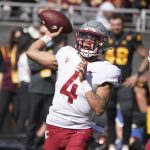Recapping the week’s key stories across the conference …
1. Three in the first
The Pac-12 produced three first-round selections in the NFL Draft, the lowest total among Power Five conferences, and no top-10 picks.
As expected, Oregon cornerback Christian Gonzalez was first off the board, heading to New England with the No. 17 selection. USC receiver Jordan Addison went No. 24 (Minnesota), and Utah tight end Dalton Kincaid was the 26th pick (Buffalo).
In a sign of the times, each player started his college career elsewhere.
Gonzalez signed with Colorado and played just one year in Eugene. Addison transferred from Pittsburgh to USC. And Kincaid attended the University of San Diego as a walk-on, then jumped to Utah.
Although the conference experienced a ho-hum Day One, the Pac-12 footprint did exceedingly well: quarterbacks Bryce Young (Pasadena), CJ Stroud (Rancho Cucamonga) and tailback Bijan Robinson (Tucson) were all top-10 picks.
Their decisions to sign elsewhere in the winter of 2019-20 marked the height of the West Coast talent drain.
2. Power Five tally
Seven Pac-12 players were picked on Day Two, while the number to watch on Day Three is 15.
The conference needs 15 selections in the final four rounds to equal last year’s total of 25 draft picks, which itself is the Pac-12’s lowest output since Utah and Colorado joined in 2011.
Selections by Power Five conference through the third round:
SEC: 31
Big Ten: 25
Big 12: 13
ACC: 12
Pac-12: 10
Of note: USC cornerback Mekhi Blackmon was the final player picked in the third round. Like Gonzalez, he started for Colorado in the 2021 season.
3. Roster purge
The Buffaloes were the talk of college football early in the week, although not necessarily in a positive fashion.
First-year coach Deion Sanders continued to remake the roster as 29 players entered the transfer portal following CU’s spring game, pushing the total number of offseason exits above 60.
Sanders and his staff have made no attempts to present the situation as anything but cutthroat roster decisions, reportedly using the word “cut” in conversations with departing players.
However unseemly the situation might appear, it’s the reality of the transfer portal era with a dash of COVID policy mixed in. Because of the roster chaos caused by the pandemic, football programs are allowed to sign an unlimited number of newcomers through the spring of 2024.
In all, the Buffaloes are expected to return just 12-to-15 scholarship players from last season.
4. Eye on the APR
We are curious about one aspect of Colorado’s roster overhaul: What impact, if any, will the mass exodus have on Colorado’s APR score?
The Academic Progress Rate was implemented by the NCAA 20 years ago as a means of holding coaches, and schools, accountable for academic performance.
The scoring system is based on retention and eligibility for each team. If the total score over a four-year period falls below the threshold, penalties affecting athletic-related activities result.
However, the NCAA attempted to account for the transfer portal two years ago when it announced that “athletes will earn (APR) points for their previous teams if they are meeting Division I progress-toward-degree requirements when they change schools.”
CU’s administration is undoubtedly monitoring the situation closely.
APR scores for the 2022-23 school year will be released (by the NCAA) in June of 2024.
5. Eugene exodus
While Colorado leads the conference in departures by a wide margin, other football programs have been hit hard.
Oregon’s case is notable, although not for quantity so much as quality: Nine of the 17 outgoing players were blue-chip recruits (four or five stars).
The Ducks are a first-rate reminder that high school recruiting rankings carry far less relevance in the transfer portal era. Their 2021 signing class under then-coach Mario Cristobal was rated No. 7 in the country by the 247Sports service.
According to the Oregonian, 16 of the 23 players have left the program.
6. Crew chief hits
Hundreds of Pac-12 players have entered the transfer portal this offseason.
So have three referees.
As the Hotline explained on Wednesday, three of the conference’s best crew chiefs are leaving for the Big Ten: Francisco Villar, and Steve Strimling and Chris Coyte, who worked the College Football Playoff last winter.
All three live in Southern California and will handle USC and UCLA home games when the schools switch conferences in 2024.
Add the retirement of a fourth referee, Michael Mothershed, and five of the Pac-12’s eight officiating crews next season will have new chiefs.
The turnover poses a supreme test of the conference’s talent pipeline under vice president for officiating David Coleman, whose eight-year tenure has been littered with on-field gaffes and off-field controversies.
7. Big words from the Big Ten
The Big Ten introduced its new commissioner, Tony Petitti, on Friday. But the comments most significant to the Pac-12 came from Illinois president Robert Jones, chair of the Big Ten’s executive council.
Asked about the possibility of additional expansion, Jones told The Athletic: “I’d be lying if I said we weren’t thinking about it. But it’s not at the top of the list. There’s no sense of urgency about it at this point.”
Jones indicated any new members would have to bring enough media rights value to make expansion worthwhile for the 16 schools.
We view the comments as further evidence that the Big Ten is unlikely to pursue Washington and Oregon in the short term, leaving the Pacific Northwest powers with one realistic option: Remain in the Pac-12 for the next media rights contract cycle, which is set to begin in the summer of 2024.
8. Well wishes
Oregon State athletic director Scott Barnes suffered a medical emergency last weekend while attending a banquet at Fresno State, his alma mater.
Fortunately, a doctor — a trauma specialist, no less — was seated nearby.
Barnes was rushed to a local hospital and eventually stabilized. By the next day, he was communicating with family.
We wish him well with the recovery.
Related posts:

Oregon wide receiver Johnny Johnson III (3) Eugene, Ore. (AP Photo/Andy Nelson)
Wilner Hotline – Oregon Ducks Hire First-Time Head Coach Pac-12 Hoops Power Ratings – Arizona, UCLA, USC at the Top
Pac-12 Hoops Power Ratings – Arizona, UCLA, USC at the Top

(AP Photo/Marcio Jose Sanchez)
Commissioner George Kliavkoff on the state of Pac-12 football (‘We’re in the valley’)
(AP Photo/Darryl Webb)
WIlner Hotline – Pac-12 Freshman of the Year QB enters the Portal, Ward to Wazzu?Jon Wilner
Jon Wilner has been covering college sports for decades and is an AP top-25 football and basketball voter as well as a Heisman Trophy voter. He was named Beat Writer of the Year in 2013 by the Football Writers Association of America for his coverage of the Pac-12, won first place for feature writing in 2016 in the Associated Press Sports Editors writing contest and is a five-time APSE honoree.
